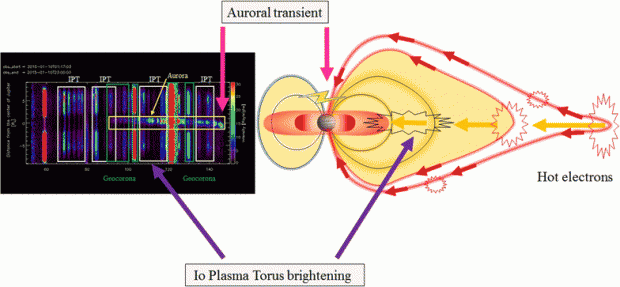- おすすめの記事
- 2017.08.20

Jupiter’s moon Io, which orbits deep inside the magnetosphere, is the most geologically active object in the solar system. Kurdalagon Patera, a volcano on Io, erupted in 2015 and became a substantial source of Jovian magnetospheric plasma. Based on Earth-orbiting spacecraft observations, Io plasma torus (IPT) exhibited the peak intensity (nearly double) of ionic sulfur emissions roughly 2 month later, followed by a decay phase. This environmental change provides a unique opportunity to determine how the more heavily loaded magnetosphere behaves. Indeed, the extreme ultraviolet spectroscope for exospheric dynamics onboard the Earth-orbiting spacecraft Hisaki witnessed the whole interval via aurora and IPT observations. A simple-minded idea would be that the centrifugal force acting on fast co-rotating magnetic flux tubes loaded with heavier contents intensifies their outward transport. At the same time, there must be increased inward convection to conserve the magnetic flux. The latter could be accompanied by (1) increased inward velocity of field lines, (2) increased frequency of inward transport events, (3) increased inward flux carried per event, or (4) combinations of them. The Hisaki observations showed that the densities of major ions in the IPT increased and roughly doubled compared with pre-eruption values. The hot electron fraction, which sustains the EUV radiation from the IPT, gradually increased on a timescale of days. Pairs of intensified aurora and IPT brightening due to the enhanced supply of hot electrons from the mid-magnetosphere to the IPT upon aurora explosions observed during both quiet and active times, enabled the study of the mid-magnetosphere/IPT relationship. Hisaki observations under active Io conditions showed that: (1) the hot electron fraction in the torus gradually increased; (2) brightening pairs were more intense; (3) the energy supplied by the largest event maintained enhanced torus emission for less than a day; (4) the time delay of a torus brightening from a corresponding aurora intensification was roughly 11 h, that is, the same as during quiet times, suggesting that the inward convection speed of high-energy electrons does not change significantly.





